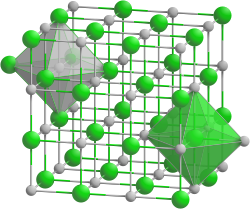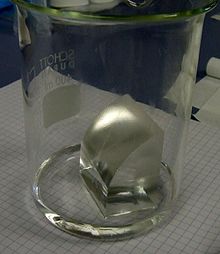Lithium fluoride
| Crystal structure | |||||||||||||||||||
|---|---|---|---|---|---|---|---|---|---|---|---|---|---|---|---|---|---|---|---|

|
|||||||||||||||||||
| __ Li + __ F - | |||||||||||||||||||
| Crystal system |
Cubic area-centered |
||||||||||||||||||
| Space group |
Fm 3 m (No. 225) |
||||||||||||||||||
| Lattice parameters |
4.026 Å |
||||||||||||||||||
| Coordination numbers |
Li [6], F [6] |
||||||||||||||||||
| General | |||||||||||||||||||
| Surname | Lithium fluoride | ||||||||||||||||||
| Ratio formula | LiF | ||||||||||||||||||
| Brief description |
colorless to white solid |
||||||||||||||||||
| External identifiers / databases | |||||||||||||||||||
|
|||||||||||||||||||
| properties | |||||||||||||||||||
| Molar mass | 25.94 g mol −1 | ||||||||||||||||||
| Physical state |
firmly |
||||||||||||||||||
| density |
2.64 g cm −3 |
||||||||||||||||||
| Melting point |
845 ° C |
||||||||||||||||||
| boiling point |
1680 ° C |
||||||||||||||||||
| solubility |
little in water (1.3 g l −1 at 25 ° C) |
||||||||||||||||||
| Refractive index |
1.3921 |
||||||||||||||||||
| safety instructions | |||||||||||||||||||
|
|||||||||||||||||||
| MAK |
2.5 mg m −3 based on fluorine |
||||||||||||||||||
| Toxicological data | |||||||||||||||||||
| Thermodynamic properties | |||||||||||||||||||
| ΔH f 0 |
−620 kJ mol −1 |
||||||||||||||||||
| As far as possible and customary, SI units are used. Unless otherwise noted, the data given apply to standard conditions . Refractive index: Na-D line , 20 ° C | |||||||||||||||||||
Lithium fluoride (LiF), the lithium salt of hydrofluoric acid , forms colorless, white-looking, only slightly water-soluble crystals. Lithium fluoride hydrates are not known.
Manufacturing
Lithium fluoride is produced by reacting an aqueous lithium hydroxide or lithium carbonate solution with hydrogen fluoride , followed by concentration and drying.
properties
Lithium fluoride crystallizes in the sodium chloride structure ( KZ = 6) in the space group Fm 3 m (space group no. 225) with the lattice parameter a = 402.6 pm . The solubility in water is only 1.3 g / l. Lithium fluoride is only sparingly soluble in water because the lattice energy is greater than the hydration energy . Aqueous solutions have a slightly alkaline reaction (pH 8). Furthermore, it does not form hydrates as they are known from the other lithium halides.
Due to the small ion radii of the lithium cation and the fluoride anion , lithium fluoride has a very high lattice energy of 1034 kJ / mol. This causes the high melting and boiling points of the salt. The standard enthalpy of formation of lithium fluoride is Δ H f 0 = −620 kJ / mol. It has a high permeability for electromagnetic radiation in the infrared range , in visible light and in the ultraviolet . An 8 mm thick single crystal made of lithium fluoride allows more than 60% of the radiation through for wavelengths from 140 nm to 6000 nm.
Lithium fluoride and calcium fluoride form a eutectic with the composition 80.5 mol percent LiF and 19.5 mol percent CaF 2 , which melts at 769 ° C.
use
Single crystals of lithium fluoride can be used in IR spectrometers as prisms or in X-ray spectroscopy as monochromator crystals . In the production of aluminum lithium fluoride can be used in electrolytic baths are used. Lithium fluoride crystals can be used in radiation detectors for ionizing radiation , especially in thermoluminescence dosimeters . Often only the salt from the isotope 6 Li doped with copper is used for this purpose.
Individual evidence
- ↑ a b c Entry on lithium fluoride in the GESTIS substance database of the IFA , accessed on December 7, 2019(JavaScript required) .
- ↑ a b c d data sheet lithium fluoride from AlfaAesar, accessed on February 6, 2010 ( PDF )(JavaScript required) . .
- ^ H. Kojima, SG Whiteway, CR Masson: Melting points of inorganic fluorides . In: Canadian Journal of Chemistry . 46 (18), 1968, pp. 2968-2971, doi : 10.1139 / v68-494 .
- ↑ a b David R. Lide (Ed.): CRC Handbook of Chemistry and Physics . 89th edition. (Internet version: 2009), CRC Press / Taylor and Francis, Boca Raton, FL, Properties of the Elements and Inorganic Compounds, pp. 4-72.
- ↑ David R. Lide (Ed.): CRC Handbook of Chemistry and Physics . 90th edition. (Internet version: 2010), CRC Press / Taylor and Francis, Boca Raton, FL, Index of Refraction of Inorganic Crystals, pp. 10-246.
- ↑ Merck Index; an Encyclopedia of Chemicals, Drugs, and Biologicals. Vol. 11, 11th edition. Merck & Co., Rahway, NJ 1989, p. 871.
- ↑ a b Entry on lithium fluoride in the ChemIDplus database of the United States National Library of Medicine (NLM)
- ↑ Farmakologiya i Toksikologiya. Vol. 40, p. 329, 1977.
- ^ A b A. F. Holleman , E. Wiberg , N. Wiberg : Textbook of Inorganic Chemistry . 101st edition. Walter de Gruyter, Berlin 1995, ISBN 3-11-012641-9 , p. 1170.
- ^ AF Holleman , E. Wiberg , N. Wiberg : Textbook of Inorganic Chemistry . 101st edition. Walter de Gruyter, Berlin 1995, ISBN 3-11-012641-9 , p. 1151.
- ↑ G. Brauer (Ed.): Handbook of Preparative Inorganic Chemistry. vol. 1, 2nd edition. Academic Press, 1963, p. 235.
- ^ Lithium fluoride at Korth Crystals
- ^ Armin Schneider, Jürgen Kutscher: Course internship in general and inorganic chemistry . Dr. Dietrich Steinkopff Verlag, Darmstadt 1974, ISBN 978-3-642-95950-9 , p. 108 ( limited preview in Google Book search).
- ↑ Online data sheet ( Memento from July 3, 2012 in the Internet Archive ) (PDF; 135 kB) from SOLAR Laser Systems
- ↑ WE Roake: The Systems CaF 2 -LiF and CaF 2 -LiF-MgF 2 . In: Journal of The Electrochemical Society . tape 104 , no. 11 , 1957, ISSN 0013-4651 , pp. 661-662 , doi : 10.1149 / 1.2428441 .
- ↑ Entry on lithium fluoride. In: Römpp Online . Georg Thieme Verlag, accessed on February 11, 2015.
- ↑ Script on optical materials ( Memento from October 21, 2012 in the Internet Archive ).
- ↑ Solvaychemicals (PDF; 106 kB)
- ↑ Hanno Krieger: Fundamentals of radiation physics and radiation protection . 4th edition. Springer-Verlag, Wiesbaden 2012, ISBN 978-3-8348-2238-3 , p. 252 ( limited preview in Google Book search).
- ↑ L. Herforth, M. Frank: Thermoluminescence dosimetry with LiF for radiation therapy and radiation protection control . In: Cechoslovackij fiziceskij zurnal B . tape 13 , no. 3 , 1963, ISSN 0011-4626 , pp. 219-221 , doi : 10.1007 / BF01875275 .



